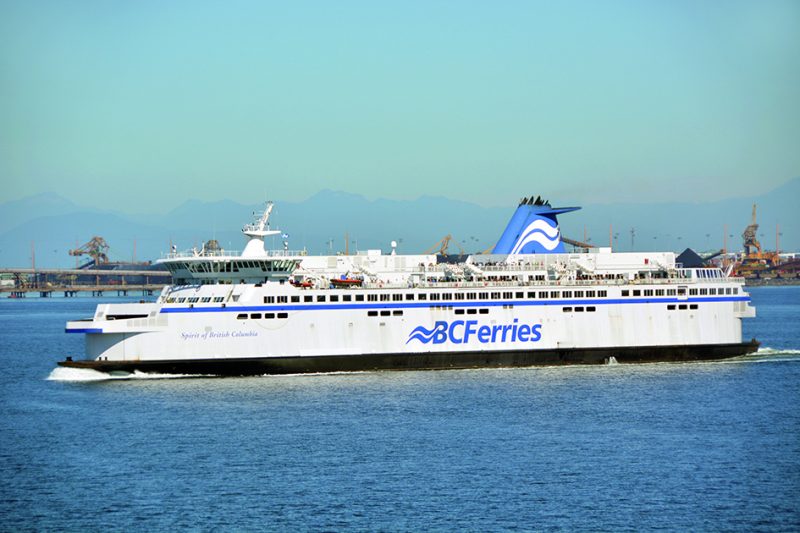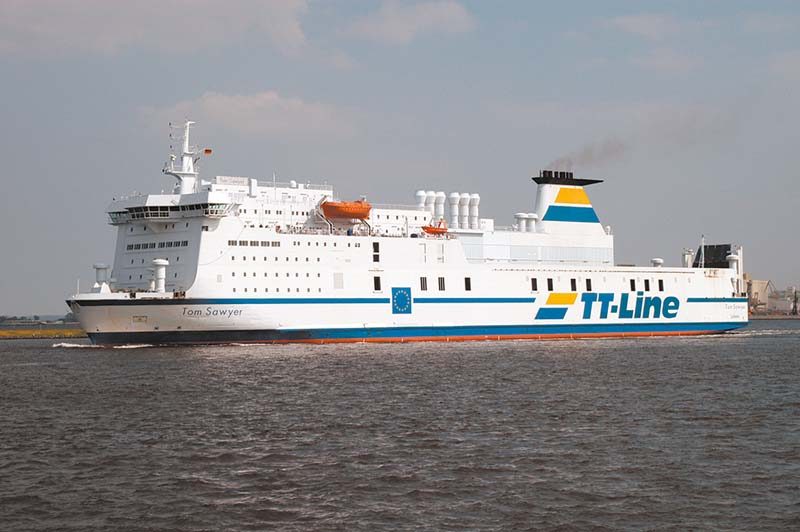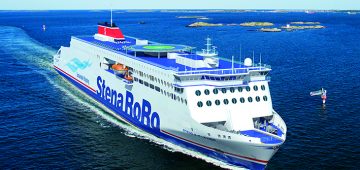Balearia’s 20,238gt/2009 built Bahama Mama was introduced between Denia, Ibiza and Palma de Mallorca prior to the introduction of the Cecilia Payne (ex-Jonathan Swift) on 1st June. The Ro-Pax ship then switched to Melilla-Almeria/Malaga. Balearia now also has the 33,958gt/1999 built Ro-Pax Rosalind-Franklin (ex-Finnclipper) for the Barcelona-Palma service and the 7,363gt/1989 built Bridge, both on charte

BC Ferries’ 21,958gt/1993 built Spirit of British Columbia (above) returned to service on 7th June on the Metro Vancouver (Tsawwassen)-Victoria (Swartz Bay) route following the completion of a mid-life upgrade at the Remontowa Shiprepair Yard in Gdansk, Poland. The vessel had returned home from Europe on 5th May. Sistership Spirit of Vancouver Island will undergo her own mid-life upgrade from autumn 2018 to spring 2019. The vessel is the first of two to be converted to operate on LNG and is the first passenger vessel in the world to refuel LNG via delivery on a fully enclosed vehicle deck. The Salish Class vessels introduced last year were the first passenger vessels in the world to fuel LNG on an open vehicle deck via delivery truck. Both of these innovations were conceived by BC Ferries and designed, engineered and built by BC Ferries and its partners. The LNG is provided by FortisBC and can be reliably delivered in British Columbia. Other upgrades included the renewal of navigation equipment, propulsion equipment components including gearboxes, rudders, steering system, bow thrusters, propeller blades, LED lighting, more efficient air conditioning equipment to reduce energy consumption and four marine evacuation systems. In addition to the LNG conversion, BC Ferries upgraded the vessel’s passenger areas with new carpeting, furniture upholstery, new table tops, added a new Arbutus Coffee Bar on Deck 6 and doubled the size of the Passages onboard shop.
CalMac announced in May that the new and long-awaited propeller shaft from Denmark for the Clansman would be fitted during a dry docking in Greenock between 1st and 12th June resulting in a return to service on 13th June. In the ship’s absence there had been an amended service on the Mallaig Armadale route and the Mallaig Lochboisdale route was suspended. Additional sailings were provided on the Barra to Eriskay route enabling passengers to travel to South Uist via Oban-Castlebay on the same day. The Loch Bhrusda was also deployed on the Skye route to provide additional sailings for the duration of the maintenance period.
Clyde Marine Services has resumed the Gourock-Kilcreggan ferry service using the Chieftain, the vessel originally built to replace the Kenilworth on the service. More recently the former Lymington based passenger vessel Island Princess was used on the route but reliability dropped to unacceptable levels.

Finnlines has reshuffled its services between Denmark and Finland and, as of 28th May, offers a direct Helsinki-Aarhus service. There will also be a direct connection between Aarhus and Uusikaupunki, which offers new possibilities for cargoes between Denmark and Western Finland. Turku will also be available as a destination via transhipment in Travemünde. The new weekly service between Travemünde and Aarhus is especially suitable for all kinds of rolling cargo, particularly for high and heavy cargo unable to cross the bridge over the Kiel Canal due to weight restrictions.
Fjord1 christened the first battery-powered ferry ordered from Havyard on 14th May. This is the first of thirteen battery-powered ferries with auto-crossing technology being built for Fjord1 at Havyard Ship Technology in Leirvik. The first 2,100gt vessel was named the Husavik and will operate the Husavik-Sandvikvåg service in Hordaland county. The auto-crossing system is monitored by the Captain, who can take over manual control if necessary. In addition to the existing fleet, the company has 22 hybrid electric ferries scheduled for delivery over the next two years, 13 from Havyard, 3 from Tersan, 3 from Sefine, 2 from Cemre and one from Fjellstrand.
Incat Crowther has delivered the 45m long/12m beam Seastreak Commodore, ordered in response to significant growth in passenger volume at Seastreak, and brings the operator’s fleet of Incat Crowther-designed vessels to a total of eight. At 45m in length with a capacity for 600 passengers, the Seastreak Commondore is the highest capacity UCSG kClass fast ferry ever built. Whilst sharing similar overall dimensions, the vessel represents a step forward from the fleet’s previous large ferries, Seastreak Wall Street, Seastreak New Jersey, Seastreak Highlands and Seastreak New York. The vessel was built at Gulf Craft, Louisiana and is powered by four MTU 12V4000 M64 EPA Tier III main engines providing redundancy whilst operating efficiently at a modest rating. The vessel is propelled by KaMeWa 63S4 waterjets. During sea trials in the fully loaded condition, the vessel achieved more than 38 knots at 100% MCR. The service speed in 35 knots and she has a crew of 6.

TT-Line and Stena Line are ending their co-operation on the Rostock-Trelleborg route as of 15th September. The two companies have been providing each other with capacity on their year-round services between the German and Swedish ports. TT-Line said that it has decided to deploy its six vessels on the Rostock service in response to capacity needs by customers. In order to be able to cater for these needs, the company renewed the cafeteria on deck seven of the 26,796gt/1995 built Nils Dacke and 26,790gt/1995 built sister ship Robin Hood. In addition, the 36,468gt/2001 built Ro-Pax vessel Peter Pan is currently at a shipyard in Bremerhaven on a prolonged lengthening project to increase cargo capacity by extending the ship by 30m. The 220m long/3,000 lanemetre capacity ship finally returned to service after a five-month stay in Bremerhaven at the beginning of June, serving the Trelleborg-Travemünde, Trelleborg-Rostock and Trelleborg-Swinoujscie routes. From 9th June the 26,478gt/1989 built Tom Sawyer (above) and 26,790gt/1995 built Robin Hood have been operating a weekly Trelleborg (Sweden)-Klaipeda (Lithuania) service.

Unity Line of Poland is planning up to four LNG/Hybrid powered and rotor sail assisted newbuilds plus a custom built LNG bunker tanker. The first ship at least will feature four vertical wind rotor sails (not of the Flettner type) to generate up to 1279kW in wind speeds of 20m/s. The new ferry concept is a 204.00m long, 31.80m beam and 9.30 hull depth ship with a 9,000 deadweight capacity, the maximum for the port of Ystad. The design will also have the in-built capability to be easily lengthened to 225m when Ystad harbour facilities are enlarged. In their basic configuration (before lengthening) the vessels would each offer 3,600 lanemetres of freight capacity with accommodation for 521 passengers in 155 two-berth and 47 three-berth cabins, two Owner’s staterooms and 48 reclining seats. The ships will feature a crew of 72. Propulsion will be provided by four dual fuel Warstila W6L50DF engines, rated at 5850 kW each powering twin propellers. Parent company Polish Steamship Company also appears intent on ordering up to 15 LNG fuelled ocean going lakers (geared bulk carriers designed for operation on the Great Lakes and St. Lawrence Seaway) with a deadweight capacity of 36,500t each for delivery 2020-2025.




Comments
Sorry, comments are closed for this item